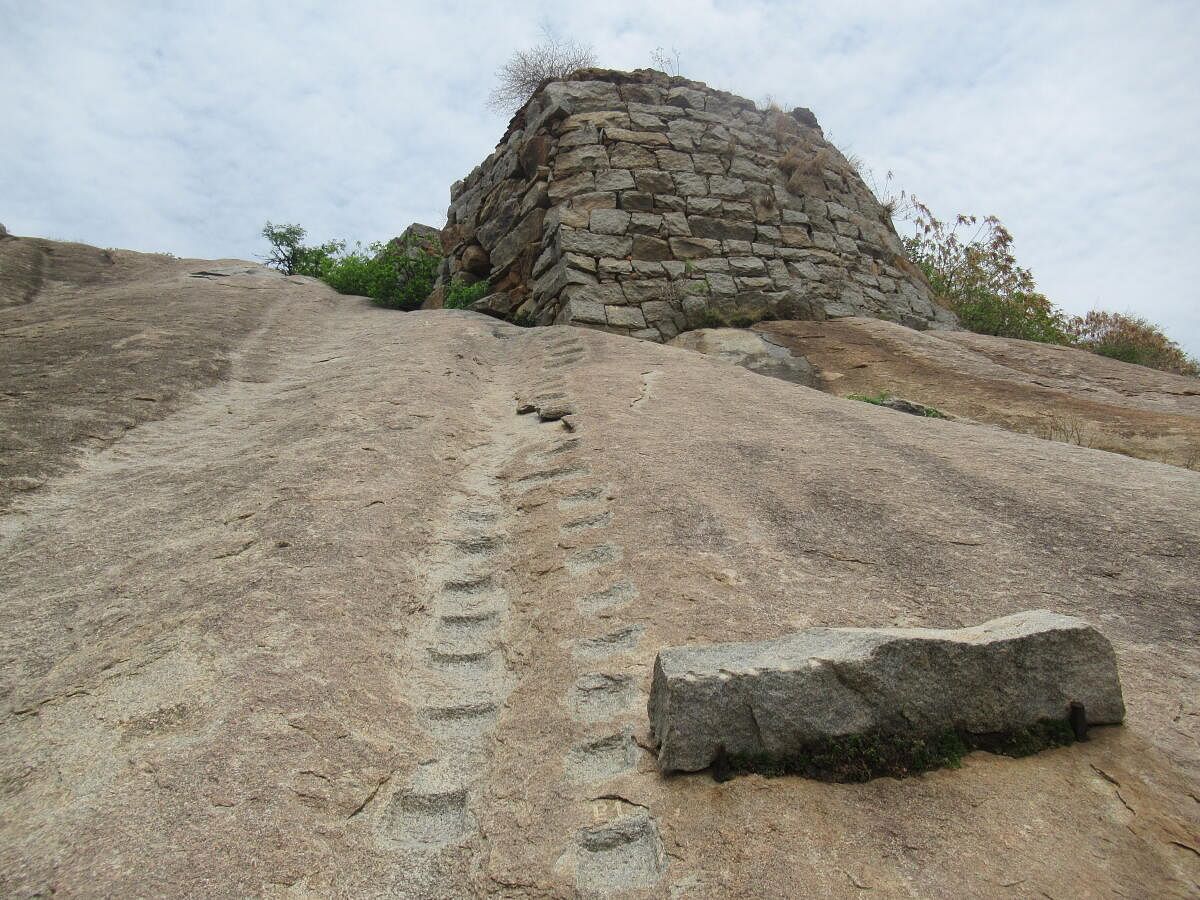

On a hot summer day, I got down at Koratagere bus stand to explore the ancient fort on the hill overlooking this small town. Walking on the main road, a short distance from here, I observed a small yellow signboard indicating the direction towards Gangadhareshwara temple, which lies inside the fort at the centre of the hill. Mysore Archaeological Survey (MAS) reports give a detailed description of this hill.
The antiquity of Koratagere can be glimpsed in two of the inscriptions dated 1627 and 1656 mentioned in Epigraphia Carnatica Vol XII. One of them, a Dana Shasana mentions Holavanahalli Dodda Rana Baire Goudaraya donating money to every household for marriages, auspicious ceremonies and festivals. It gives the details of grants made, including rice, oil, coconut, areca nut, betel leaves, turmeric and saffron.
The narrow lane wound uphill, with scattered boulders still standing amidst the houses. At the foothill, under a large peepal tree, I spotted a unique set of three Nagadevatas carved in primitive style. As I started climbing upwards, the ruins of the fort walls became visible.
Where the steps start, there once stood a stone slab with a dancing figure carved on it, which has since vanished, as I discovered during my later treks of this hill. Remains of an old grand entrance gate with a column and four broken beams with curved corners reminded me of its glorious past.
Ancient temple
The steps led me to the ancient temple of Gangadhareshwara extending out of the rock face, with its gopura at the rear half embedded in the rock. As described in detail in the 1918 MAS report, the temple with two Dwarapalakas has Gangadhareshwara, Parvati and Srinivasa as the main deities. I also observed the Navagrahaas on a raised platform. From one side of the temple, I could climb up and touch the feet of the Nandi bull right on top of the entrance.
There is a small passage with ancient steps leading down to a kalyani (sacred pond) nestled in the rocky crevice. The carving of a Nandi there seems to be of recent origin. It has an inscription of ‘Om’, carved in Kannada. The loud croaking sounds of the frogs and chirping of insects I heard were unusual at this mid-afternoon hour!
There is a very steep and slippery path, with uneven broken steps carved on the rock surface, to reach the next level of the fort. It was probably intentionally made so, by the earlier rulers. The MAS report mentions a spot here that used to be a tanka-sale (mint) for making gold coins for former chiefs.
After crossing over a small tunnel-like entrance and through thorny bushes, I was delighted to discover at the summit a small shrine of Basava, the Nandi bull. From this height, the views of various water bodies, temples’ gopuras, far-off hills and lush green patches of land were quite breathtaking.
I did go all around to locate the ‘Dalaavayee Gundu’ stones, but could not distinguish them from hundreds of other boulders. As per the MAS report, those stones represented the traitors who betrayed the Palegar princess Bayyamma. She had also built the Bayyamma pond, presently called ‘Koratagere Kere’.
Climbing down the hill, I walked through the narrow lane reaching the lake edge. A short distance from here is the ancient ‘Gokalada Anjaneya’ temple, presently known as ‘Shri Rama Mandira’. New construction and concretisation of the streets before the temple have probably embedded most of the Sati stones that were once recorded to be here, though one of them was jutting out of the ground, with only the top portion visible.
Back on the main road, there was another ancient temple, the Chandra Mouleshwara Swamy Devalaya — most of it in a dilapidated state. River Swarnamukhi flows in front of this temple. The ruins of old fort walls amid the forest on its other bank are visible too. It is amazing that this small town has history unfolding at every nook and corner.